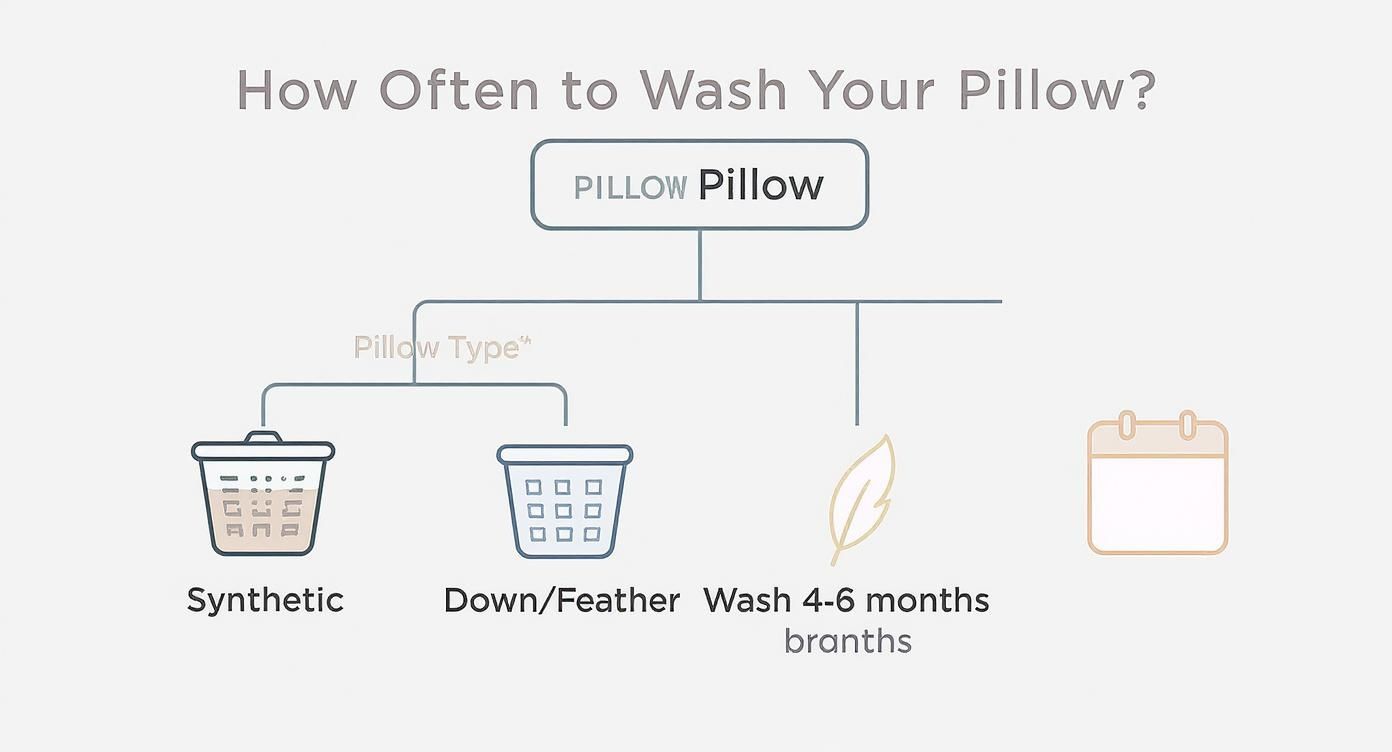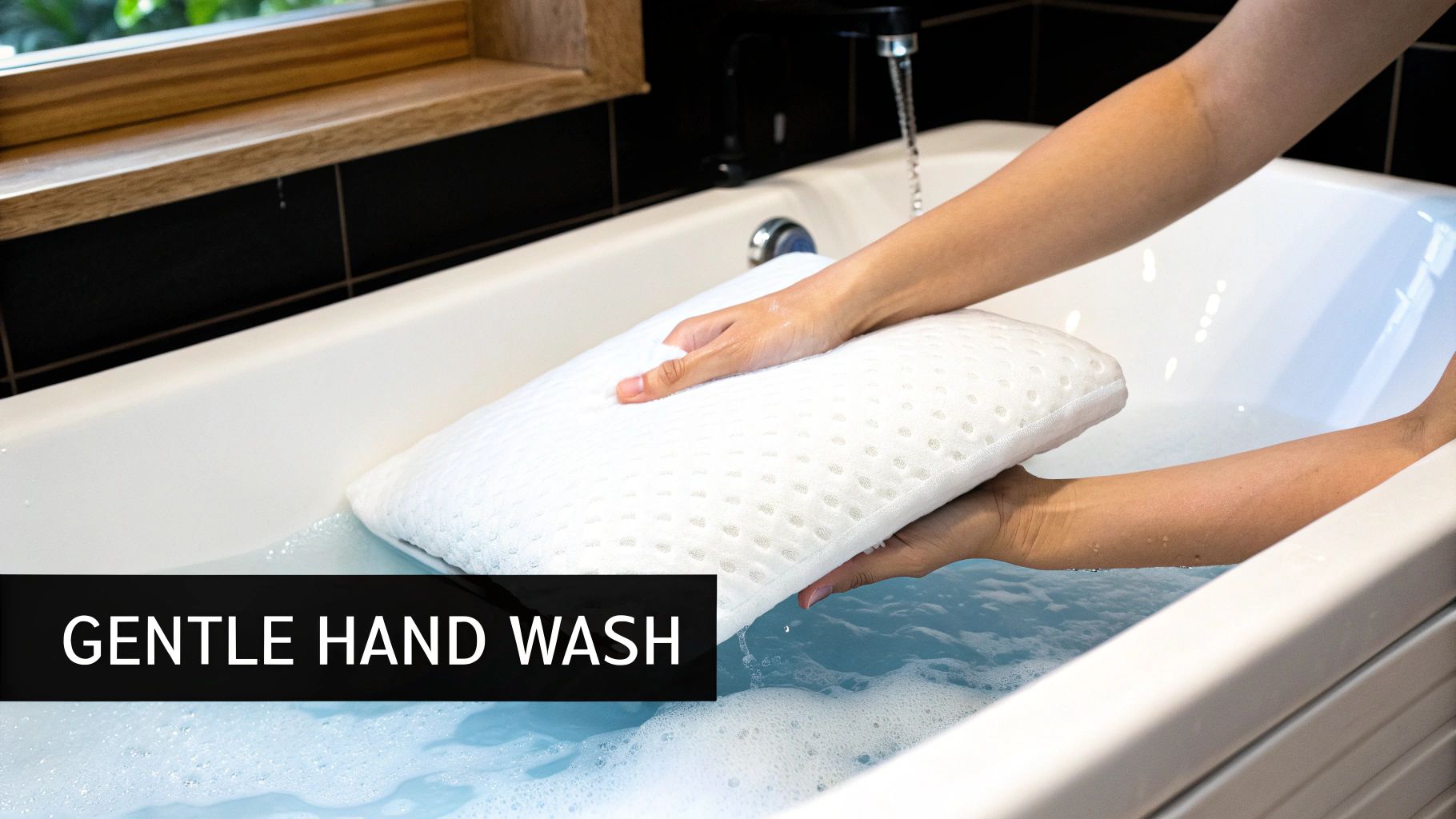Ever stop to think about what's hiding inside your pillow? It’s not just fluff. Over time, pillows soak up sweat, dead skin cells, and body oils, becoming a five-star hotel for dust mites and bacteria. This hidden buildup can trigger allergies, cause skin breakouts, and ruin your sleep quality.
Learning how to wash a pillow is one of the simplest and most effective ways to create a healthier sleep environment. This guide cuts through the confusion, offering clear, actionable steps for every type of pillow, so you can get back to a truly clean and restful night's sleep.
Why You Absolutely Must Wash Your Pillows
Thinking a clean pillowcase is enough is a common mistake. What's lurking beneath the surface is the real issue. The warm, slightly damp interior of a pillow is the perfect breeding ground for allergens. Washing them properly is non-negotiable for your health.
So, how often should you do it?
Quick Guide: How Often to Wash Your Pillow
This simple table shows how frequently you should wash different pillow types to keep them hygienic and fresh.
| Pillow Type | Recommended Washing Frequency |
|---|---|
| Down & Feather | Every 6 months |
| Memory Foam | Every 2-3 months (spot clean) |
| Latex | Every 2-3 months (spot clean) |
| Polyester/Synthetic | Every 3-6 months |
| Bamboo | Every 3-6 months |
Following these guidelines prevents the buildup of grime and keeps your pillows feeling and smelling new.
The Real Impact of a Dirty Pillow
A clean pillow is about more than just a fresh scent; it's a cornerstone of your wellbeing. Research shows that after just two years, up to one-third of a pillow's weight can be composed of dead skin, bugs, dust mites, and their droppings.
- Better Skin: All those trapped oils and bacteria can clog pores, leading to acne and skin irritation. A clean pillow means a clearer complexion.
- Allergy Relief: Dust mites are a primary trigger for allergy and asthma symptoms. A thorough wash eliminates them. For more tips, see our ultimate guide to hypoallergenic bedding care.
- Longer Pillow Life: Regular cleaning removes oils and sweat that break down pillow fibres, helping it maintain its supportive shape for longer.
First Step: Always Check the Care Label
Before you throw your pillow in the wash, a few quick checks can save you from a laundry disaster. The most important step is to find the care label. This little tag is your instruction manual, telling you exactly what the manufacturer recommends.
If the label is gone, don't worry. As a general rule, most down, feather, and synthetic pillows are machine-washable. Memory foam and latex, however, almost always require hand washing.
The Simple 'Fold Test'
Here’s a quick test to see if your pillow is still worth washing. Just fold it in half and let go.
- If it springs back: Great! It still has plenty of supportive life left and is ready for a wash.
- If it stays folded: This is a clear sign the internal structure has broken down. No amount of washing can save it.
A pillow that fails the fold test needs replacing. A flat, lifeless pillow can harm your neck alignment and sleep quality. If you need a new one, our guide on how to choose the right pillow can help you find the perfect match.

How to Wash a Pillow in the Washing Machine
If you have synthetic or down pillows, the washing machine is your best friend. Knowing how to machine wash a pillow correctly can bring it back to life, making it feel fresh, clean, and fluffy again.

Here's the most important tip: always wash two pillows at once. A single pillow will throw the machine's drum off balance during the spin cycle, causing violent shaking. Two pillows balance the load, ensuring a smooth and effective wash.
Another common mistake is using too much detergent. You only need a small amount of a gentle, low-suds liquid detergent. Powdered types can leave chalky clumps in the filling, while too much soap is hard to rinse out, leaving a stiff residue.
The Best Machine Settings
Getting the settings right is key to protecting your pillows. Here’s a quick rundown of the best options:
- Cycle: Choose the gentle or delicate cycle. The slower agitation is much kinder to the pillow's seams and filling.
- Water Temperature: Use warm water. Hot water can damage delicate fibres in both down and synthetic fills.
- Detergent: Use a small amount of liquid detergent—about half of what you'd use for a normal load.
This gentle approach is especially important for high-quality down pillows. If you've invested in them, you'll want to preserve their softness. Learn more about the specific needs of goose down pillows in Australia to see why this careful handling matters.
Don't Skip This Final Step
Once the main wash cycle is done, don't take the pillows out yet.
Run an extra rinse and spin cycle. This guarantees every trace of detergent is flushed out, which is the secret to avoiding stiff, clumpy pillows. It also wrings out more water, cutting down on drying time and preventing mildew.
How to Dry Your Pillows Perfectly
Properly drying your pillows is just as important as washing them. Rushing this step leads to a lumpy, damp pillow that can quickly grow mould. The goal is a pillow that's completely dry and wonderfully fluffy.
If you're using a machine dryer, the golden rule is low heat. High heat can melt synthetic fibres or ruin natural ones like down.
Getting the Fluff Back
To prevent clumping and restore loft, toss in a couple of wool dryer balls. They bounce around, breaking up lumps and helping air circulate for a more even dry. No dryer balls? Two clean tennis balls inside thick socks work just as well.
Every 30 minutes, pause the dryer, pull the pillows out, and give them a good shake. This redistributes the filling and helps you check for any damp spots in the centre.
Also, remember that a clean dryer vent is crucial for safety and efficiency. Check out these expert dryer vent cleaning tips for safer homes to prevent fire hazards and ensure your dryer works properly.
How to Air-Dry Pillows
No dryer? No problem. Air-drying works perfectly, it just requires more patience.
Lay your pillows flat on a clean surface, like a clothes airer, in a sunny, breezy spot. The direct sunlight is a great natural sanitiser.
The key is to flip and fluff them every couple of hours to ensure they dry evenly. This method is also great for larger items, which you can read about in our guide on how to wash doonas.
Be patient—a pillow can feel dry on the outside but still be damp inside. Make sure it's completely dry before putting it back on your bed.
How to Hand Wash Memory Foam and Latex Pillows
You cannot put memory foam or latex pillows in a washing machine. The aggressive spin cycle will tear the delicate foam structure apart, leaving you with a useless, lumpy mess. For these pillows, a gentle hand wash is the only way.

Fill a bathtub or large sink with lukewarm water—hot water can damage the foam. Add a small amount of gentle liquid detergent (about one tablespoon per pillow) and swish it around to create light suds.
The Gentle Cleaning Process
Carefully submerge the pillow. Instead of scrubbing, gently squeeze and press the pillow, like you're kneading dough. This pumping motion draws soapy water in and flushes out dirt, oil, and sweat.
The secret here is patience. Never twist or wring out the pillow, as this can tear the foam. Stick to the gentle squeezing motion.
Once it's clean, drain the soapy water and refill the tub with fresh, cool water. Continue squeezing the pillow to rinse out all the detergent, repeating until the water runs clear with no suds. This careful method is vital for speciality pillows, like the bamboo memory foam pillow.
How to Dry Foam Pillows
After the final rinse, gently press down on the pillow to squeeze out as much water as you can. Again, do not wring it!
Lay the pillow flat on a clean, dry towel in a well-ventilated area, away from direct sunlight or heat sources. Direct heat will make the foam brittle.
Flip it every few hours to ensure it dries evenly. Be prepared for this to take time—a foam pillow can take up to 24 hours to dry completely.
Keeping Your Pillows Fresher for Longer
Washing your pillows is a great reset, but a few simple habits can extend that clean feeling and your pillow's life.
The single most effective thing you can do is use a quality pillow protector. It acts as a barrier, shielding your pillow from sweat, oils, and allergens. This small addition makes a massive difference and is standard practice in the hospitality industry, where 65% of Australian hotels use them to reduce allergens. Discover more insights on pillow hygiene.
Simple Daily Habits for Lasting Freshness
A couple of small daily actions can also have a big impact.
- Fluff Daily: When you make your bed, give your pillows a vigorous fluff. This helps them regain their shape and airs them out, preventing musty smells.
- Air Out Weekly: Once a week, remove the pillowcases and let your pillows breathe for a few hours near an open window or in a shady spot outside.
For more home hygiene ideas, check out these effective cleaning and disinfecting tips.
Common Questions About Washing Pillows
Even with a guide, questions can pop up. Let's tackle the most common ones.
How do I get rid of yellow stains?
Those yellow stains are usually from sweat and body oils. For a simple fix, make a paste of baking soda and water, rub it onto the stains, and let it sit for 30 minutes before washing as usual. For tougher stains, pre-soak the pillow for an hour in a solution of one part white vinegar to one part water.
What’s the best detergent to use?
Always choose a gentle, low-suds liquid detergent. Powdered detergents can leave a chalky residue inside the filling. And skip the fabric softener—it can coat the fibres, especially in down pillows, ruining their natural loft and making them feel flat.
How can I be sure my pillow is completely dry?
A pillow that feels dry on the outside can still be damp in the core, creating a perfect environment for mould. Use the squeeze test: firmly squeeze the pillow in the centre. If you feel any coolness or dampness, it needs more drying time. A musty smell is another sure sign it isn't ready.
Ready to upgrade to a pillow designed for ultimate comfort and easy care? Sienna Living offers a luxurious range of pillows that provide superior support and breathability, night after night.
Explore the collection and find your perfect pillow today at Sienna Living.

